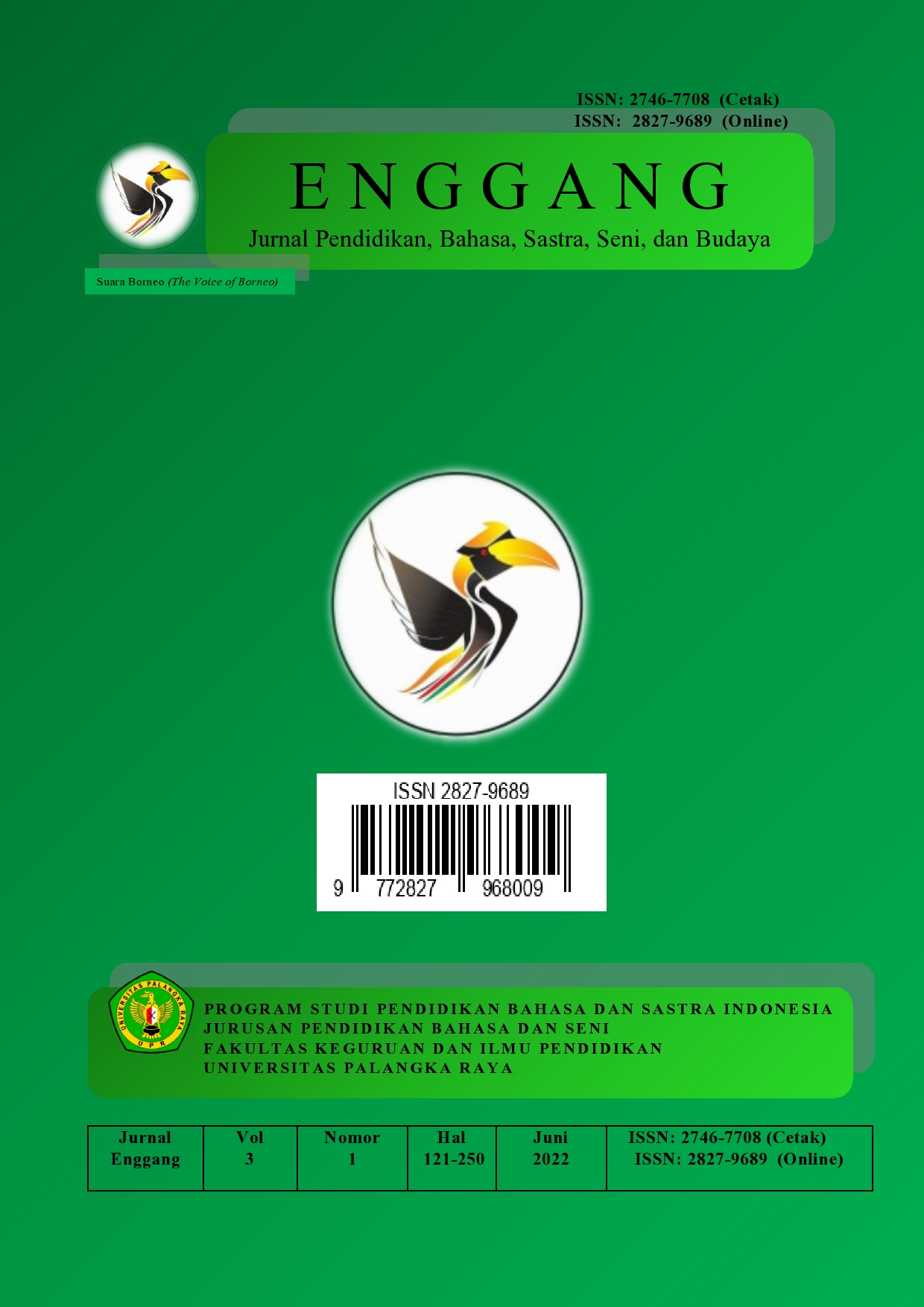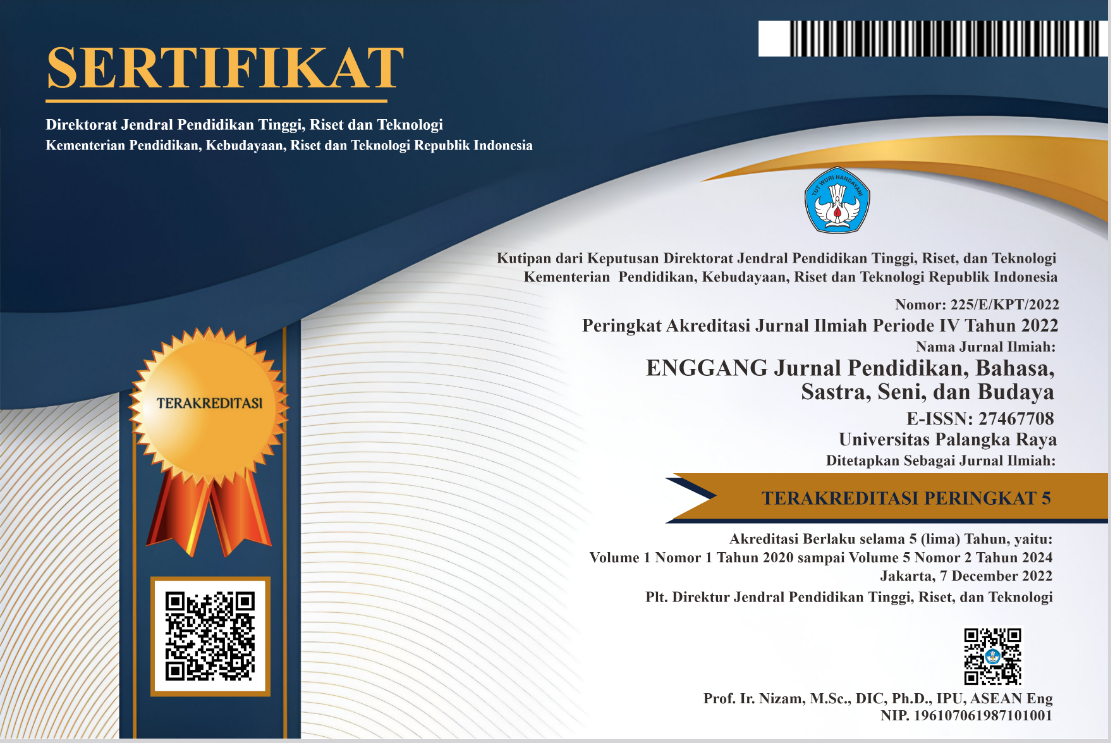Bentuk dan Proses Penciptaan Karya Tari Abhimantra pada Kompetisi Festival Kesenian Indonesia 2023 di Denpasar Bali
DOI:
https://doi.org/10.37304/enggang.v5i2.22282Keywords:
Dance Work, Competition, Form, Creation Process, Text and ContextAbstract
The article entitled "The Process of Creating Abimantra Dance Works at the 2023 Indonesian Arts Festival (FKI) in Denpasar Bali", intends to explain analytically the process of creating dance works in the context of the 2023 FKI competition or competition which opens up opportunities for the best students at higher education institutes art, to emerge as a champion. Looking at the facts of the process of creating Abhimantra dance works created in the context of this competition, it is interesting to discuss scientifically because it opens up discourse to understand the form of the work and the process of its creation in the context of competitions, where the characters are always under psychological pressure to win, represent a group or institution, and creative in the narrow space of competition rules. The formulation of the problem in this paper is to question 1) the form of the Abhimantra Dance Work and 2) the process of creating the Abhimantra Dance Work. The article research method used is qualitative research with participant observation data mining because the author is a dancer in the Abhimantra work. This article uses Sumandiyo Hadi's analytical theory regarding the form and process of creating dance works and Ahimsa Putra's analytical theory regarding the text and context of artistic works. Through this article it is concluded that 1) Abhimantra dance works are dance works in the form of duets or pairs that use the concept of surrealist dance work originating from the development of Surakarta Style vocabulary, exploration of large volume movements, risky extreme movements, and exploration of supporting elements of choreography such as costumes. , make-up, lighting and music, 2) the creation of this dance work cannot be done freely because it has to follow the technical guidelines for the competition, and 3) psychologically the creation of this dance is under the pressure of the desire to win the competition and 4) the Abhimantra dance work has distinctive choreography in the context competition interests. The writing of this scientific article considers that, in the process of creating Abhimantra dance works, creativity must be devoted to more creative energy in order to be able to create successful dance works in the context of competitions.
Downloads
References
Diplan, D., Misnawati, M., & Anwarsani, A. (2023, July). Keindahan Sastra pada Pertunjukan Sendratari “ONRUST” Sebagai Upaya Mempertahankan Ketahanan Budaya Lokal. In Prosiding Seminar Nasional dan Internasional HISKI (Vol. 3, pp. 500-508).
Edi Sedyawati. 2001. Pelestarian Seni Tradisi Dalam Program Pemerintah. Kumpulan Naskah Makalah dan Sambutan Direktur Jendral Kebudayaan Thn. 1999. Jakarta: Direktorat Jendral Kebudayaan, Departemen Pendidikan Nasional.
Eric Hobsbawm. 1987. Introduction: Inventing Tradition, Eric Hobsbawm and Terence Ranger (eds.) The Invention of Tradition. Cambridge: Cambridge University Press.
Hadi, Sumandiyo Y. 2007. Kajian Tari Teks dan Konteks. Yogyakarta: Pustaka Book Publisher.
Hadi, Sumandiyo. 2003. Aspek-Aspek Dasar Koreografi Kelompok. Yogyakarta: ELKAPHI.
Hawkins, Alma M. 1990. Mencipta Lewat Tari, Terj. Y. Sumandiyo Hadi. Yogyakarta: ISI Yogyakarta.
Humphrey, Doris. 1983, Seni Menata Tari, Terj. Sal Murgiyanto. Dewan Kesenian Jakarta.
Kemmis, S. and Mc. Taggert, R. 1988. The Action Research Planner. Dankin University.
Kusumastuti, Siti N. 2016. Perkembangan Koreografi Di Indonesia: Suatu Kajian Karya Tari Kontemporer Di Pusat Kesenian Jakarta-Taman Ismail Marzuki 1968–1987. Laporan Disertasi, Program Studi Ilmu Sejarah, Universitas Indonesia.
Munandar, Utami. 2002. Kreativitas & Keberbakatan, Strategi Mewujudkan Potensi Kreatif & Bakat, Jakarta: PT Gramedia Pustaka Umum.
Prayetno, Sugeng, 2017. Hubungan Kompetisi Kerja Dengan Organisasi Pembelajaran. Volume 1, Nomor 1, April 2017, Majalah Manajemen dan Bisnis Ganesha.
Schneede, Uwe M. 1973. Surrealism. New York: Harry N. Abrams, Inc., Publisher.
Shenita, A., Oktavia, W., Rahman, N. A., Irmareta, I. L., Subrata, H., Rahmawati, I., & Choirunnisa, N. L. (2022). Pembelajaran Seni Musik Botol Kaca Berbasis Proyek dengan Pendekatan Steam untuk Meningkatkan Kreativitas Siswa. ENGGANG: Jurnal Pendidikan, Bahasa, Sastra, Seni, dan Budaya, 3(1), 122-250.
Shri Ahimsa-Putra, Heddy. 2002. Tekstual dan Kontekstual Seni dalam Kajian Antropologi Budaya, Makalah Disajikan dalam Acara Serial Seminar Internasional Seni Pertunjukan Indonesia Seni 1. Tanggal 3 – 4 Juli 2002 di STSI Surakarta
Sylvester, David (ed). 1993. The Book of Art. Volume 8 Modern Art Journal. London: Grolier Inc.













